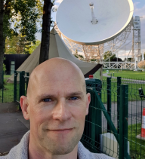Previous projects
The POINT-AGAPE survey. A microlensing survey of the disk of the Andromeda Galaxy looking for evidence of elusive compact dark matter. Dark matter is a key ingredient of modern cosmology and remains one of the major unsolved problems in physics. As a founder member of the project I constructed some simulations in advance of the survey of the signatures we might detect, as well as contributing to the analysis of the results from the real survey. Among the highlights of the survey are: the detection of a binary microlensing event allowing an accurate determination of the lens mass; a likely intra-galactic microlensing event involving a lens in one of Andromeda's satellite galaxies microlensing a star within Andromeda itself; a catalogue of 40,000 variable stars, including 20 Classical Novae (see below); and evidence that compact stellar-mass objects (possibly stellar remnants) may be responsible for a component of the dark matter within Andromeda's dark halo.
(Published papers from this project)
The Angstrom Project. I was Principal Investigator for the ANdromeda Galaxy STellar RObotic Microlensing (Angstrom) Project. Angstrom was a UK-Korean-US collaboration which employed a global network of 2m-class telescopes, including robotic telescopes, to detect short-duration microlensing events in the bulge of the Andromeda Galaxy. Survey highlights included the first real-time identification of microlensing in another galaxy beyond the Milky Way and its satellites. It also showed that robust variable star photometry is possible within the dense inner core regions of galaxies and provded a demonstrator for the potential discovery of exoplanets in other galaxies using the microlensing technique.
(Preprints/papers from this project)
Classical novae in the Andromeda Galaxy. Classical Novae (CNe) are violent explosions triggered by the accretion of gas from a star onto the surface of a white dwarf (stellar remnant) companion. Aside from gamma-ray bursts and supernovae, CNe are among the most powerful explosions in nature. They are also potentially important as astronomical distance calibrators via the maximum magnitude versus rate of decline (MMRD) or the t15 statictical relationships. Many CNe within our own Galaxy are missed due to extinction by interstellar dust, so statistcial samples of CNe are most easily obtained in nearby galaxies, such as Andromeda. Previous studies of the rate of CNe in Andromeda and in our own Galaxy had indicated a discrepancy: the measured nova rates were broadly similar despite Andromeda having roughly twice as many stars. For his PhD, Matt Darnley working with myself, Mike Bode, Andrew Newsam and POINT-AGAPE colleagues, used images from the POINT-AGAPE survey and developed automated algorithms to select CNe from the time evolution of their brighness (their lightcurve) using a sequence of images of Andromeda taken over a three-year timespan by the POINT-AGAPE survey. This is made difficult by the fact that CNe lightcurves have a wide range of profiles. However, by using automated selection we were able to determine, for the first time, how many lightcurves may have been missed due to, e.g., incomplete time coverage. The nova rate we determined of around 65 per year, with around 38 per year coming from the central bulge region of Andromeda, is significantly higher than previous studies, but crucially accounts both for the CNe we saw and those we missed within the data. Scaling this result to our own Galaxy, we found a similar nova rate per star in the two galaxies, thus resolving a long-standing puzzle.
(Published papers from this project)

 ORCiD
ORCiD